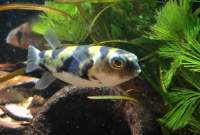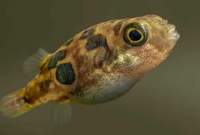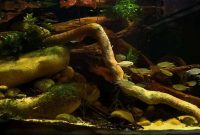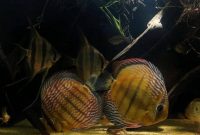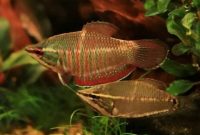If you are looking for a dwarf sucker fish for your nano aquascape tank, pitbull pleco might be a potential candidate.
These catfish only grow on averagely around 6 cm, making themselves one of the smaller species under the plecostomus family.
You might seldom hear about this animal, or even it is the first time you learn about these rare algae eater fish.
It is not surprising because the information is limited and almost never seen inhabit the tank aquarists, making them an unknown fish species.
At this moment, we would tell you as specific as possible about them, starting from general information, appearance, behavior, tank needed, breeding, and other relevance that is useful for you.
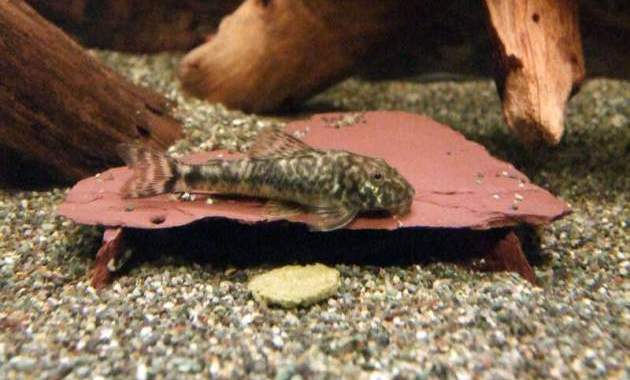
TABLE OF CONTENTS
Pitbull Pleco Overview
- Scientific Name: Parotocinclus jumbo
- Care Level: Easy – Intermediate
- Originate: Brazil
- Size: 6 cm or more
- Life Expectancy: Up to 15 years
- Diet: Algae Eater, Omnivore
- Temperament: Peaceful toward all tankmates
- Minimum Tank Size: 20 gallons
- Temperature : 20.0-26.0°C
- pH Level: 6.4-7.6
- Water Hardness: 5-15 dGH
- Compatible For Beginner: Yes, but more recommended for advanced aquarists
General Information
Parotocinclus jumbo (formerly Hypostominae gen. sp.) is another fantastic South American loricariid species. Pitbull pleco is their famous common name, but they still have some other common names that are often used by aquarists to describe this fish, including LDA25/LDA025, goby pleco, and Pitbull-sugemalle (Denmark).
These fish were first described by Britski & Garavello in 2002. The genus Parotocinclus name consists of some greek words (para in the side of + ous, otis means ear + kygklos, ou means a fish). While the species name ‘jumbo’ get from their specific epithet that refers to their huge size attained by this species in contrast to their congeners.
As the name suggests, Parotocinclus, the species under this genus, slightly look similar to otocinclus. However, the members of each genus are really different in appearance and behavior aspects.
Their distribution is only limited to far-eastern Brazil. They are not permitted for export to other countries, which makes them almost entirely unavailable in the aquarium hobby nowadays.
These dwarf catfish are one of the many species of the genus that probably be reclassified; well, you may find themselves in a new brand genus in the future.
Distribution And Habitat
Pitbull plecos originate from the Eastern Brazilian water streams. They tend to occur in Piranhas and Paraiba do Norte Rivers in Paraiba state, Mandau river’s tributaries, Canhotinho river in Pernambuco state, Salgado river in Ceara state, and water streams of Maceio city in Alagoas state, Brazil.
A type locality found in Rio Paraíba do Norte at bridge on road PB 408, in northwest of Umbuzeiro, 7°38’27″S, 35°42’30″W, Paraíba, Brazil.
In nature, they mainly inhabit the flat areas in the middle part of the river. Generally, this location is shallow and contains clear water and low currents. The substrate is composed of sands, rocks, and some marginal vegetation.
P. jumbo is not a subtropical species; the water temperature in their wild habitat tends to be quite warm.
Pitbull Pleco Appearance
A primary difference between genus parotocinclus and otocinclus is by the existence of adipose fin (a tiny fleshy fin that appears at the posterior to the dorsal and anterior of the caudal fin ) in the former.
They have a rounded head, making it shape similar to a goby, which is why they are called a ‘Goby pleco’ in some areas.
Pitbull pleco comes in various grey colors, ranging from medium to strong grey, or even seen in black tint. It is combined with some golden-brown or greenish shades and dark spots.
Based on information from an aquarist, their color usually resembles the substrate color in their environment.
The full size of Parotocinclus jumbo can reach up to 6 cm; from some reports, the wild type can reach up to 7 cm.
An individual pitbull plecostomus lifespan can be more than 15 years, of course, with the best care practices.

Behavior And Temperament
As much like other freshwater aquarium algae eater fish, they are social and peaceful towards their tankmates, even to small-sized fishes.
It would be better if you kept the LDA025 in a small group range of three to six individuals rather than a single fish.
They are not well in food and territorial competition, so never keep them in the same tank with aggressive, larger, boisterous fish.
Like bulldog pleco, they are nocturnal, which means they do many night activities. When they feel stressed or scarred, pitbull pleco might be buried themselves underneath the substrate to hide.
As the bottom-dwellers, they typically spend most periods laying their body on the tank substrate. These suckermouth fish rarely move to different surfaces, except during feeding time, which usually happens at night.
While during the light period, they tend to spend most of their time hiding or burying themselves beneath the substrate.
Like most plecos, they are hardier fish with well-capability in adaption in the less oxygenated environment to survive.
Sexual Dimorphism
The males have a long pelvic fin, the tip of which lengthens beyond the origin of the anal fin. While the position of a male’s urogenital papilla is located after the anal opening. On the contrary, the female’s pelvic fin’s tip does not reach the anal fin origin, and the duct of the urogenital system is open to the inner cloacal cavity.
Additionally, other distinguishing features between both gender are males have great bluish-green saddles that are shining on their back, but females do not have it. Nonetheless, a female generally is plumper than a male. It’s identical to most freshwater fish species.
Pitbull Pleco Reproduction
In the wild habitat, the rainy season usually positively affects on their spawning. Pitbull pleco commonly mates during the night in the area containing sandy substrate dense with plants and bogwoods.
Their eggs are sticky, and these catfish often lay them on the grass. Eggs will hatch after about three days.
Some aquarists say their breeding method is similar to corydoras in the aquarium. The first step is conditioning the breeding pair. You should keep pitbull plecos in a large group, then leave them to pair naturally.
After that, separate them for several weeks; it can stimulate them to be enthusiastic to mate once they have been reintroduced to a breeding tank.
During the separation, feed them with live food, pellet, or frozen meals thrice a day. You will see the difference between both genders after 30 days of doing this, with females showing plumper bodies and full of eggs.
Keep them back together in the breeding aquarium, and add cool water to adjust the temperature after three days. The temperature decreases to 65F after a few days, similar to the rainy weather. Some people also suggested turning off the aquarium light during the spawning.
The mating begins with the courtship period, where the male chases the female for a while. Once the spawn is started, the male would be lies above the female body and wait for her to release the eggs.
After the eggs got fertilized, females will stick them into small groups on different surfaces inside the tank, usually on leaves and wall glass. This process takes about one hour; once in a while, the female takes a short break.
Their eggs will hatch after three days; some of them probably are poor because of the fungus. To prevent it, you can add some dried alder cones or ramshorn snails; these snails could eat the fungi.
To avoid predation by the adult goby plecos, you should remove them from the breeding tank. Alternatively, you can move the eggs to a tumbler incubator, breeding box, or fry tank to gain the chances of better survival.
What should you do if your fish does not spawn? What kind of tips triggers them to breed?
It frequently happens due to some factors; performing a 50 % water change can be a solution. They may be willing to spawn after a couple of days. Make sure to switch off the light during the breeding session.
Feeding And Diet
As an algae eater crew, pitbull pleco particularly excels in wiping out any types of it, such as oedogonium algae, rhizoclonium algae, green dust algae, fuzz algae, and more.
However, your planted aquarium maybe does not provide enough to feed them properly. Well, you need some additional snacks such as algae wafers, pellets, and spirulina tabs.
They are also known as omnivores, which can accept vegetables and some live or frozen meals, including zucchini, lettuces, spinach, brine shrimps, and bloodworms. The live food enhances their coloration and health.
Tank Requirements And Aquarium Setup
As the fish are smaller than other bottom dweller plecostomus, making them does not need a huge tank. The 20-gallon tank is enough to accommodate a single or a pair of pitbull pleco fish; however, the small group consisting of 3-6 individuals requires a larger tank, at least 30 gallons.
Due to their habitat, which majorly contains sand and rock, well, you should set it up in such a way to mimic their natural environment. Use fine sand type and avoid the sharp gravels to prevent their skins are scratched while exploring the tank to find any snack and dig up the substrate to bury themselves.
Use the best quality filtration system; a canister filter type that features with button adjusting water flowing rates is recommended to keep the water quality stable and produce enough CO2. The water level movement does not matter, they can tolerate the slow to fast water current, but a low to medium rate is advised.
Powerhead, wave maker and air pump are optional. Remember, they are one of the vigorous plecostomus fish species; as long as your tank installs a perfect water cycle system, everything is fine.
These small freshwater catfish prefer cold water, so utilization of a heater certainly does not need.
Selecting the hardscapes from nature is suggested than artificial. The older submerged driftwood and stones are more perfect than the newest one; it does not affect water parameters. However, if you still want to apply artificial decorations like caves, plastic plants, coconut shells, etc., it is no problem. Make sure that all is safe for them.
They do not have specific lighting intensity; they can live well under low to high lighting. For your note, if you keep some aquarium plants that need a strong light level to develop, you would need a chiller to hold the temperature stay stable. Intense radiation can increase the water temperature; it might make the fish feel uncomfortable.
Another trick is planting some floating vegetation such as salvinia natans or azolla. It can minimize the straightforward light beam effect from an aquarium lamp.
Give pitbull pleco tank the standard lighting period about 6-8 hours is enough.
Parotocinclus jumbo known does not bother the live aquatic plants; choose the appropriate plants that fit with your setup. The tough and thicker aquatic plants like anubias and cryptocoryne are ideal for planting in their aquascape tank.
There are some terms that you should be met to keep P. Jumbo in your aquarium:
- pH level: 6.4-7.6
- Water temperature: 68-78.8°F (20.0-26.0°C)
- Water Hardness: 5-15 dGH
Maintenance And Care
In the aquascaping world, a healthy aquarium would make the population inside happier. For achieving this goal, regular water change is become one of the essential factors; changing the water around 30% weekly.
The goby plecostomus grows optimally in the lower water temperature; positioning your aquarium near the window, around the kitchen, or even outside the house is a terrible practice. Ensure to locate your fish tank and stay away from direct sunlight because it can raise the temperature.
The presence of algae is good for them, but regrowing their own need much time, while the fish should eat every day. The solution for this situation is you can produce your own algae in another tank; you just need some stones, an aquarium, and high lighting.
When the alga is thriving on the stone at the cultivated tank, substitute the rock at the pitbull tank with those. Repeat this process to generate more algae to meet the demand for food supply. Feed your pitbull pleco with live food at least thrice a week to maintain their coloration.
To reduce the aquarium temperature significantly, you can enter some amount of cold water or ice blocks. Installing a cooling system helps the temperature stagnant. Purchasing a chiller or creating your own cooler kit from CPU fans is a long-term and more practical solution.
Pitbull Pleco Tankmates
As much like other smaller peaceful tropical fish, they do not find it suitable to keep together with territorial, aggressive, and bigger fish; they usually intimidate the poor and invasive species like p. Jumbo.
You should avoid the reliable food catcher species; they can outcompete the pitbull pleco easily during feeding time, especially when you give live food.
Limiting the number of similar omnivorous species such as guppy and molly would positively impact pitbull pleco. We know both species sometimes nibble on algae, which will reduce their population rapidly.
The best pitbull plecos tankmates are the species with similar characteristics and sizes. The tetra’s species always become the primary choice for most calm fish’s friends.
Some gourami species are not too large; like sparkling gourami, licorice gourami, and honey gourami are also suitable for them. Zebra danios, corydoras, and bala shark are other tropical fish you can choose as their friends.
Any type of tropical shrimp and snail is also accepted as their friend. They should share their main food (algae), and ensure to provide other food resources to supply their needs.
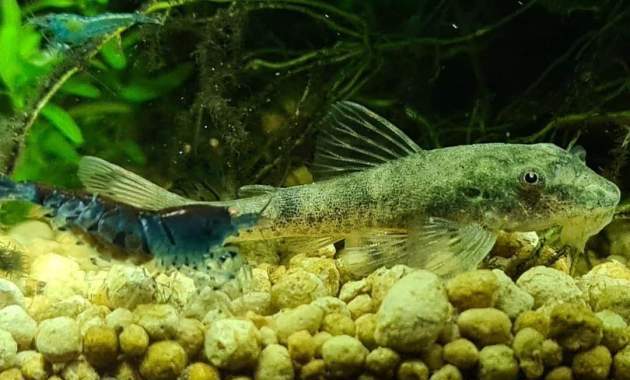
Potential Diseases
Luckily, they do not have a specific illness but probably can be affected by some common freshwater sicknesses such as ich, dropsy, bacterial & fungus infected, bloat, fin rot, and pop eye.
Do not worry; there are many cure products on the market against these diseases if your fish are infected. Always read the procedure first before using the medicines.
Availability
These dwarf pelcostomus have been bred in captivity by some local breeders, sometimes present in one to another tank’s owner through the organized aquarium hobby, and appear in local club fish auctions or such.
Unfortunately, they are not available for shipping internationally, making fish hobbies on the other side of the world unable to feel the experience when watching the beautifulness of pitbull plecos.
Is Pitbull Pleco Fish Suitable For Newbies?
Even though they are strong catfish, which means they are easy to pet, gobby pleco is more suitable for some keepers with enough experience due to infrequent availability on the trades. It is deeply regretted if they accept improper maintenance, which may lead to severe problems.
So, if you are a beginner in keeping pleco species, it would be better if you select other common pleco species that are rich in stock and easy to care for as your aquarium inhabitant.


